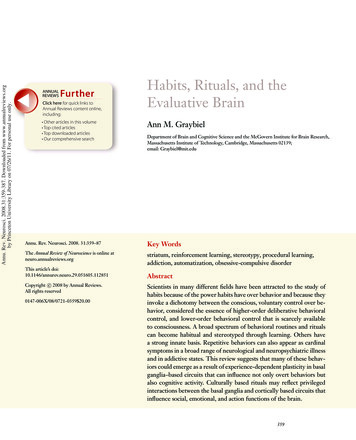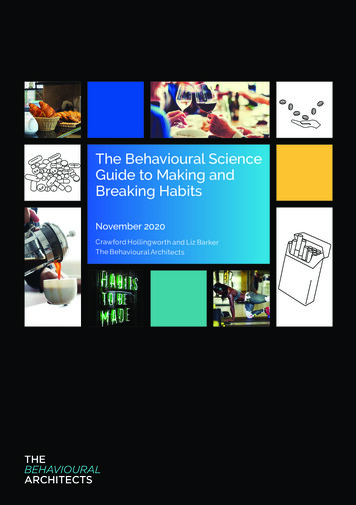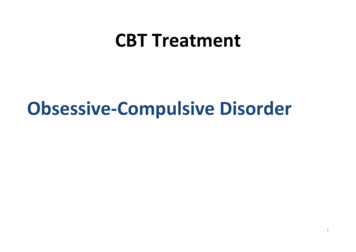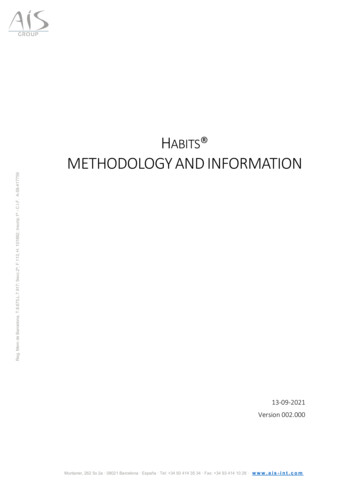
Transcription
Annu. Rev. Neurosci. 2008.31:359-387. Downloaded from www.annualreviews.orgby Princeton University Library on 07/26/11. For personal use only.ANNUALREVIEWSFurtherClick here for quick links toAnnual Reviews content online,including: Other articles in this volume Top cited articles Top downloaded articles Our comprehensive searchHabits, Rituals, and theEvaluative BrainAnn M. GraybielDepartment of Brain and Cognitive Science and the McGovern Institute for Brain Research,Massachusetts Institute of Technology, Cambridge, Massachusetts 02139;email: Graybiel@mit.eduAnnu. Rev. Neurosci. 2008. 31:359–87Key WordsThe Annual Review of Neuroscience is online atneuro.annualreviews.orgstriatum, reinforcement learning, stereotypy, procedural learning,addiction, automatization, obsessive-compulsive disorderThis article’s doi:10.1146/annurev.neuro.29.051605.112851c 2008 by Annual Reviews.Copyright All rights reserved0147-006X/08/0721-0359 20.00AbstractScientists in many different fields have been attracted to the study ofhabits because of the power habits have over behavior and because theyinvoke a dichotomy between the conscious, voluntary control over behavior, considered the essence of higher-order deliberative behavioralcontrol, and lower-order behavioral control that is scarcely availableto consciousness. A broad spectrum of behavioral routines and ritualscan become habitual and stereotyped through learning. Others havea strong innate basis. Repetitive behaviors can also appear as cardinalsymptoms in a broad range of neurological and neuropsychiatric illnessand in addictive states. This review suggests that many of these behaviors could emerge as a result of experience-dependent plasticity in basalganglia–based circuits that can influence not only overt behaviors butalso cognitive activity. Culturally based rituals may reflect privilegedinteractions between the basal ganglia and cortically based circuits thatinfluence social, emotional, and action functions of the brain.359
ContentsAnnu. Rev. Neurosci. 2008.31:359-387. Downloaded from www.annualreviews.orgby Princeton University Library on 07/26/11. For personal use only.INTRODUCTION . . . . . . . . . . . . . . . . . .DEFINITIONS OF HABITLEARNING IN COGNITIVENEUROSCIENCE ANDEXPERIMENTALPSYCHOLOGY . . . . . . . . . . . . . . . . . .COMPUTATIONAL APPROACHESTO HABIT LEARNING:HABIT LEARNING ANDVALUE FUNCTIONS . . . . . . . . . . . .EXTREME HABITS . . . . . . . . . . . . . . . . .LEARNING HABITS ANDLEARNING PROCEDURES . . . . .HABITS, RITUALS, ANDFIXED-ACTION PATTERNS . . . .STEREOTYPIES . . . . . . . . . . . . . . . . . . . .HABITS, STEREOTYPIES,AND RITUALISTICBEHAVIORS IN HUMANS . . . . . . .HABITS AND RITUALS:THE BASAL GANGLIA ASA COMMON THEME . . . . . . . . . . .360362365369370371372374375Habit is the most effective teacher of all things.—PlinyWe are what we repeatedly do. Excellence, then, isnot an act, but a habit.—AristotleHabit is second nature, or rather, ten times nature.—William JamesFor in truth habit is a violent and treacherousschoolmistress. She establishes in us, little by little,stealthily, the foothold of her authority; but having by this mild and humble beginning settled andplanted it with the help of time, she soon uncoversto us a furious and tyrannical face against whichwe no longer have the liberty of even raising oureyes.—MontaigneINTRODUCTIONHabit, to most of us, has multiple connotations.On the one hand, a habit is a behavior that wedo often, almost without thinking. Some habits360Graybielwe strive for, and work hard to make part of ourgeneral behavior. And still other habits are burdensome behaviors that we want to abolish butoften cannot, so powerfully do they control ourbehavior. Viewed from this broad and intuitiveperspective, habits can be evaluated as relativelyneutral, or as “good” (desirable) or as “bad” (undesirable). Yet during much of our waking lives,we act according to our habits, from the time werise and go through our morning routines untilwe fall asleep after evening routines. Taken inthis way, habits have long attracted the interest of philosophers and psychologists, and theyhave been alternatively praised and cursed.Whether good, bad, or neutral, habits canhave great power over our behavior. Whendeeply enstated, they can block some alternate behaviors and pull others into the habitual repertoire. In early accounts, habits werebroadly defined. Mannerisms, customs, and rituals were all considered together with simpledaily habits, and habituation or sensitization(the lessening or increase in impact of stimuli and events with repetition) were included.Much current work on habit learning in neuroscience has pulled away from this broad viewin an effort to define habit in a way that makesit accessible to scientific study. Much insightcan also be gained by extending such constructsof habit and habit learning to include the richarray of behaviors considered by ethologists,neuropharmacologists, neurologists, and psychiatrists, as well as by students of motor control. Below, I review some of the definitions ofhabit that have developed in cognitive neuroscience and psychology and how these viewshave been formalized in computational theories. I then point to work on extreme habitsand compulsions, ritualistic behaviors and mannerisms, stereotypies, and social and cultural“habits” and suggest that these are critical behaviors to consider in a neuroscience of habitformation.This proposal is based on mounting evidence that this broad array of behaviors canengage neural circuits interconnecting theneocortex with the striatum and related regions of the basal ganglia. Different basal
Annu. Rev. Neurosci. 2008.31:359-387. Downloaded from www.annualreviews.orgby Princeton University Library on 07/26/11. For personal use only.ganglia–based circuits appear to operate predominantly in relation to different types ofcognitive and motor actions, for example, inintensely social behaviors such as mating andin the performance of practiced motor skills.Remarkably, however, evidence suggests thatmany of these basal ganglia-based subcircuitsparticipate during the acquisition of habits, procedures, and repetitive behaviors, and these maybe reactivated or misactivated in disorders producing repetitive thoughts and overt behaviors.A starting point is to consider defining characteristics of habits. First, habits (mannerisms,customs, rituals) are largely learned; in currentterminology, they are acquired via experiencedependent plasticity. Second, habitual behaviors occur repeatedly over the course of days oryears, and they can become remarkably fixed.Third, fully acquired habits are performed almost automatically, virtually nonconsciously,allowing attention to be focused elsewhere.Fourth, habits tend to involve an ordered, structured action sequence that is prone to beingelicited by a particular context or stimulus. Andfinally, habits can comprise cognitive expressions of routine (habits of thought) as well asmotor expressions of routine. These characteristics suggest that habits are sequential, repet-NeocortexEvaluationitive, motor, or cognitive behaviors elicited byexternal or internal triggers that, once released,can go to completion without constant conscious oversight.This description is familiar to many whostudy animal behavior and observe complex repetitive behaviors [fixed action patterns(FAPs)]. Some of these appear to be largely innate, such as some mating behaviors, but othersare learned, such as the songs of some orcenebirds. Repetitive behaviors and thoughts arealso major presenting features in human disorders such as Tourette syndrome and obsessivecompulsive disorder (OCD). Stereotypies andrepetitive behaviors appear in a range of otherclinical disorders including schizophrenia andHuntington’s disease, as well as in addictivestates. I suggest that there may well be a common theme across these behavioral domains.Many of these repetitive behaviors, whethermotor or cognitive, are built up in part throughthe action of basal ganglia–based neural circuitsthat can iteratively evaluate contexts and selectactions and can then form chunked representations of action sequences that can influenceboth cortical and subcortical brain structures(Figure 1). Both experimental evidence andcomputational analysis suggest that a shift fromSelectionChunkingFAPs: fixed actionpatternsOCD: obsessivecompulsive ingVTA-SN complexBrain stem structures(e.g., superior colliculus, PPN)Figure 1Schematic representation of the development of habits through iterative action of cortico–basal gangliacircuits. Circuits mediating evaluation of actions gradually lead to selection of particular behaviors that,through the chunking process, become habits. PPN, pedunculopontine nucleus; SN, substantia nigra;STN, subthalamic nucleus; VTA, ventral tegmental area.www.annualreviews.org Habits, Rituals, and the Evaluative Brain361
largely evaluation-driven circuits to those engaged in performance is a critical feature ofhabit learning. Chronic multielectrode recordings suggest that within the habit productionsystem, as habits are acquired, neural activitypatterns change dynamically and eventually settle into specific chunked patterns. This shiftin neural activity from variable to repetitivematches the explore-exploit transition in behavioral output from a testing, exploratory modeto a focused, exploitive mode as habitual behaviors crystallize. This process may be critical to allow the emergence of habitual behaviors as entire structured entities once they arelearned.Annu. Rev. Neurosci. 2008.31:359-387. Downloaded from www.annualreviews.orgby Princeton University Library on 07/26/11. For personal use only.S-R: stimulusresponseDEFINITIONS OF HABITLEARNING IN COGNITIVENEUROSCIENCE ANDEXPERIMENTAL PSYCHOLOGYClassic studies of habit learning distinguishedthis form of learning as a product of a procedural learning brain system that is differentiable from declarative learning brain systemsfor encoding facts and episodes. These definitions rest on findings suggesting that thesetwo systems have different brain substrates(Knowlton et al. 1996, Packard & Knowlton2002, Packard & McGaugh 1996). Deficits inlearning facts contrast vividly with the preserved habits, daily routines, and procedural capabilities of patients with medial temporal lobedamage (Salat et al. 2006). By contrast, patientswith basal ganglia disorders exhibit, in testing,procedural learning deficits and deficits inimplicit (nonconsciously recognized) learningsuch as performance on mazes and probabilistic learning tasks in which the subject learns theprobabilities of particular stimulus-response(S-R) associations without full awareness(Knowlton et al. 1996, Poldrack et al. 2001).The nonconscious acquisitions of S-R habitsby amnesic patients has been documented mostclearly by the performance of a patient wholearned a probabilistic task with an apparent total lack of awareness of the acquired habit (Bayley et al. 2005).362GraybielDespite these distinctions, human imagingexperiments suggest that both the basal ganglia (striatum) and the medial temporal lobeare active in such probabilistic learning tasks.When task conditions favor implicit learning,however, activity in the medial temporal lobedecreases as striatal activity increases, and whenconditions favor explicit learning, the reverse istrue (Foerde et al. 2006, Poldrack et al. 2001,Willingham et al. 2002). Moreover, in diseasestates involving dysfunction of the basal ganglia,medial temporal lobe activity can appear underconditions in which striatal activity normallywould dominate (Moody et al. 2004, Rauchet al. 2006, Voermans et al. 2004). These findings demonstrate conjoint but differentiablecontributions of both the declarative and theprocedural memory systems to behaviors, aswell as interactions between these two.Comparable distinctions have been drawnfor memory systems in experimental animals.The striatum is required for repetitive S-R orwin-stay behaviors (for example, always turning right in a maze to obtain reward) as opposed to behaviors that can be flexibly adjustedwhen the context or rules change (for example, not just turning right, but turning towardthe rewarded side even if it is now on theleft). By contrast, the hippocampus is requiredfor flexible (win-shift) behaviors (Packard &Knowlton 2002, Packard & McGaugh 1996).Nevertheless, the control systems for thesebehaviors cannot be simply divided into hippocampal and basal ganglia systems becauseboth types of behavior can be supported bythe striatum, depending on the hippocampaland sensorimotor connections of the striatal regions in question (Devan & White 1999, Yin &Knowlton 2004). Moreover, as conditional procedures are learned, neural activities in the striatum and hippocampus can become highly coordinated in the frequency domain (DeCoteauet al. 2007a).In an effort to promote clearly interpretableexperimentation on habit formation, Dickinsonand his collaborators developed an operationaldefinition of habits using characteristics ofreward-based learning in rodents (Adams &
Annu. Rev. Neurosci. 2008.31:359-387. Downloaded from www.annualreviews.orgby Princeton University Library on 07/26/11. For personal use only.Dickinson 1981, Balleine & Dickinson 1998,Colwill & Rescorla 1985). In the initial stagesof habit learning, behaviors are not automatic.They are goal directed, as in an animal working to obtain a food reward. But with extendedtraining or training with interval schedules ofreward, animals typically come to perform thebehaviors repeatedly, on cue, even if the valueof the reward to be received is reduced so thatit is no longer rewarding (for example, if theanimal is tested when it is sated or if its food reward has been repetitively paired with a noxiousoutcome). Dickinson defined the goal-oriented,purposeful, nonhabitual behaviors as actionoutcome (A-O) behaviors and labeled the habitual behaviors occurring despite reward devaluation as S-R behaviors. Thus, in additionto habits being learned, repetitive, sequential,context-triggered behaviors, habits can be defined experimentally as being performed not inSMArelation to a current or future goal but rather inrelation to a previous goal and the antecedentbehavior that most successfully led to achievingthat goal.The central finding from lesion work basedon the reward-devaluation paradigm is that thetransition from goal-oriented A-O to habitualS-R modes of behavior involves transitions inthe neural circuits predominantly controllingthe behaviors (Figure 2). Specifically, experiments suggest that different regions of the prefrontal cortex, the striatum, and the amygdalaand other limbic sites critically influence thesetwo different behavioral modes.In rats, lesions in either the sensorimotor striatum (dorsolateral caudoputamen) orthe infralimbic prefrontal cortex reduce theinsensitivity to reward devaluation that defines habitual behavior in this paradigm. Withsuch lesions, the animals exhibit sensitivity toA-O: MIOFCSICNPVSVSFigure 2Dynamic shifts in activity in cortical and striatal regions as habits and procedures are learned. Sensorimotor,associative, and limbic regions of the frontal cortex (medial and lateral views) and striatum (singlehemisphere) are shown for the monkey (left), and corresponding striatal regions are indicated for the rat(right). These functional designations are only approximate and are shown in highly schematic form.ACC, anterior cingulate cortex; CN, caudate nucleus; CP, caudoputamen; MI, primary motor cortex;OFC, orbitofrontal cortex; P, putamen; SI, primary somatosensory cortex; SMA, supplementary motor area;VS, ventral striatum.www.annualreviews.org Habits, Rituals, and the Evaluative Brain363
Annu. Rev. Neurosci. 2008.31:359-387. Downloaded from www.annualreviews.orgby Princeton University Library on 07/26/11. For personal use only.reward value (A-O behavior) rather than habitual (S-R) behavior, even after overtraining(Killcross & Coutureau 2003, Yin & Knowlton2004). By contrast, lesions of either the caudomedial (associative) striatum or the prelimbicprefrontal cortex reduce the sensitivity to reward devaluation that defines goal-oriented behavior in this paradigm; the animals are habitdriven (Killcross & Coutureau 2003, Yin et al.2005). The fact that lesions in either the striatum or the frontal cortex are disruptive suggeststhat the controlling systems represent neuralcircuits that have both cortical and subcortical components. In macaque monkeys, the basolateral amygdala and the orbitofrontal cortex are also required for sensitivity to rewarddevaluation (Izquierdo et al. 2004, Wellmanet al. 2005). Thus multiple components ofthe goal-oriented system have been demonstrated across species, and these include regionsstrongly linked with the limbic system (Balleineet al. 2003, Corbit & Balleine 2005, Gottfriedet al. 2003, Wellman et al. 2005).Like the declarative vs. habit system distinction made in studies on humans, the distinction based on these experiments betweenaction-outcome vs. stimulus-response systemsis not absolute (Faure et al. 2005). Evidence suggests that these are not independent “systems.”For example, after training that produces habitual behavior in rats, goal-oriented behaviorcan be reinstated if the infralimbic prefrontalcortex is inactivated (Coutureau & Killcross2003). This finding suggests that the circuitscontrolling goal-directed behavior may be actively suppressed when behavior becomes habitual (Coutureau & Killcross 2003). The dichotomy between A-O and S-R behaviors alsodoes not reflect the richness of behavior outside the narrow boundaries of their definitionsin reward-devaluation paradigms (for example,when multiple choices are available or different reward schedules are used). The idea thatthere is a dynamic balance between control systems governing flexible cognitive control andmore nearly automatic control of behavioral responses supports the long-standing view fromclinical studies that frontal cortical inhibitory364Graybielzones can suppress lower-order behaviors. Thisview has become important in models of suchsystem-level interactions (Daw et al. 2005).Most of these studies have been based on theeffects of permanent lesions made in parts of either the dorsal striatum or the neocortex. Theuse of reversible inactivation procedures suggests that during early stages of instrumentallearning, activity in the ventral striatum (nucleus accumbens) is necessary for acquisition ofthe behavior (Atallah et al. 2007, Hernandezet al. 2002, Hernandez et al. 2006, Smith-Roe &Kelley 2000). This requirement for the nucleusaccumbens is apparently transitory: After learning, inactivation of the nucleus accumbens hasless or no effect. Notably, inactivating the dorsolateral striatum during the very early stagesof conditioning does not block learning andcan even improve performance. This last result at first glance seems to conflict with themany reports concluding that the dorsolateralstriatum is necessary for habit learning. However, these results fit well with the view, encouraged here, that the learning process is highlydynamic and engages in parallel, not simplyin series, sets of neural circuits ranging fromthose most tightly connected with limbic andmidbrain-ventral striatal reward systems to circuits engaging the dorsal striatum, neocortex,and motor structures such as the cerebellum.Several groups have suggested that eventually the “engram” of the habit shifts to regionsoutside the basal ganglia, including the neocortex (Atallah et al. 2007, Djurfeldt et al. 2001,Graybiel 1998, Houk & Wise 1995, O’Reilly& Frank 2006). Evidence to settle this pointis still lacking. There could be a competitionbetween the early-learning ventral striatal system and the late-learning dorsal striatal system (Hernandez et al. 2002), an idea parallelto the proposal that, in maze training protocols that eventually produce habitual behavior,the hippocampus is required for learning earlyon, whereas later the dorsal striatum is required(Packard & McGaugh 1996). However, thingsare not likely to be so simple. The dorsal striatum can be engaged very early in the learningprocess (Barnes et al. 2005, Jog et al. 1999). And
Annu. Rev. Neurosci. 2008.31:359-387. Downloaded from www.annualreviews.orgby Princeton University Library on 07/26/11. For personal use only.“the striatum” and “the hippocampus” each actually comprise a composite of regions thatare interconnected with different functionalnetworks.COMPUTATIONAL APPROACHESTO HABIT LEARNING:HABIT LEARNING ANDVALUE FUNCTIONSWork on habit learning has been powerfullyinvigorated by computational neuroscience. Acritical impetus for this effort came from the pioneering work of Sutton & Barto (1998), whichexplicitly outlined the essential characteristicsof reinforcement learning (RL) and summarized a series of alternative models to accountfor such learning (RL models). For experimental neuroscientists, this work is of remarkableinterest because neural signals and activity patterns are being identified that fit well with theessential elements of RL models (Daw et al.2005, Daw & Doya 2006). The key characteristics of these models are that an agent (animal,machine, algorithm) undergoing learning startswith a goal and senses and explores the environment by making choices (selecting behaviors) inorder to reach that goal optimally. The agent’sactions are made in the context of uncertaintyabout the environment. The agent must explorethe environment to reduce the uncertainty, butit must also exploit (for example, by selectingor deselecting an action) to attain the goal. Sequences of behaviors are seen as guided by subgoals, and the learning involves determining theimmediate value of the state or state-action set(a reward function), the estimated (predicted)future value of the state in terms of that reward (a value function). To make this value estimate, the agent needs some representation offuture actions (a policy). Then the choice can beguided by the estimated value of taking a givenaction in a given state with that policy (the action value). These value estimates are principaldrivers of behavior. Most behaviors do not immediately yield primary reward, and so ordinarily they involve the generation of a model of theaction space (environment) to guide future ac-tions (planning) in the sense of optimal control.Thus the control of behavior crucially dependson value estimates learned through experience.A pivotal convergence of RL models and traditional learning experiments came with twosets of findings based on conditioning experiments in monkeys (Figure 3). First, dopaminecontaining neurons of the midbrain substantianigra pars compacta and the ventral tegmental area (VTA) can fire in patterns that correspond remarkably closely to the properties ofa positive reward prediction error of RL models such as in the temporal difference model(Montague et al. 1996, Romo & Schultz 1990,Schultz et al. 1997). Second, during such conditioning tasks, striatal neurons gradually acquire a response to the conditioning stimulus, and this acquired response depends ondopamine signaling in the striatum (Aosakiet al. 1994a,b). These two sets of findings suggested a teacher (dopamine)–student (striatum)sequence in which dopamine-containing nigralneurons, by coding reward-prediction errors,teach learning-related circuits in the striatum(Graybiel et al. 1994). The actor-critic architecture and its variants, in which the critic supplies value predictions to guide action selectionby the actor, have been used to model these relationships (Schultz et al. 1997). Many studieshave now focused on identifying signals corresponding to the parameters in models of thislearning process.The firing characteristics of midbraindopamine-containing neurons suggest thatthey can signal expected reward value (reward probability and magnitude including negative reward prediction error) and motivationalstate in a context-dependent manner (Bayer &Glimcher 2005, Morris et al. 2004, Nakaharaet al. 2004, Satoh et al. 2003, Tobler et al. 2005,Waelti et al. 2001), that they are specialized torespond in relation to positive but not aversivereinforcements, and that they may code uncertainty (Fiorillo et al. 2003, Hsu et al. 2005,Niv et al. 2005, Ungless et al. 2004) or salience(Redgrave & Gurney 2006). These characteristics may, among others, account for theremarkable capacity for placebo treatments towww.annualreviews.org Habits, Rituals, and the Evaluative BrainRL: reinforcementlearningVTA: ventraltegmental area365
abDopamine and rewardTANs and reward30Spikes/ sImpulses/binAnnu. Rev. Neurosci. 2008.31:359-387. Downloaded from www.annualreviews.orgby Princeton University Library on 07/26/11. For personal use only.2010201000Foodtouch0.1 s0.1 sClickrewardFigure 3Reward-related activity of dopamine-containing neurons of nigral and striatal neurons. (a) Activity of nigral-VTA complex neurons(from Romo & Schultz 1990). (b) Activity of tonically active neurons in the striatum (from Aosaki et al. 1994b) Spike rasters (below) andhistograms of those spikes (above) are aligned (vertical lines) at touch of the food reward (a) and at the conditional stimulus click soundindicating reward.elicit dopamine release in the striatum (de laFuente-Fernandez et al. 2001). Action value encoding was not detected by the original experimental paradigms used for recording from thedopaminergic neurons, which focused mostlyon noninstrumental learning. Morris et al.(2006), using a decision task with a block design, have now shown that the action value of afuture action can be coded in the firing of theseneurons. This result is important in favoringcomputational models that take into accountthe value of a given action in a given state (the Qvalue). Remarkably, the dopaminergic neuronscan signal which of two alternate actions willsubsequently be taken in a given experimentaltask with a latency of less than 200 ms after thestart of a given trial. This fast response suggeststhat another brain region has coded the decision and sent the information about the forthcoming action to the nigral neurons (Morriset al. 2006; compare Dommett et al. 2005).366GraybielModels that incorporate the value of chosen actions in a particular state include those known asthe state-action-reward-state-action or SARSAmodels and advantage learning models.Ironically, a main candidate for a neuralstructure that could deliver the action valuesignal to the midbrain dopamine-containingneurons is the striatum, the region originallythought to be the student of the dopaminergic substantia nigra. Many projection neurons in the striatum encode action value whenmonkeys perform in block design paradigms inwhich action values are experimentally manipulated (Samejima et al. 2005). Other structuresprojecting to the nigral dopamine-containingneurons are also candidates, including the pedunculopontine nucleus (one of the brain stemregions noted in Figures 1 and 5), the raphe nuclei including the dorsal raphe nucleus, the lateral habenular nucleus and forebrain regions including the amygdala and limbic-related cortex,
e habitsAddictionsStereotypiesAnnu. Rev. Neurosci. 2008.31:359-387. Downloaded from www.annualreviews.orgby Princeton University Library on 07/26/11. For personal use N complexBrain stem structures(e.g., superior colliculus, PPN)Figure 4Schematic diagram suggesting the progression of functional activation in cortico-basal ganglia circuits as highly repetitive habits,addiction, and stereotypies emerge behaviorally. Note that in contrast to normal everyday habit learning (Figure 1), even the earlystages of extreme habit formation involve steps that tend not to be readily reversible. PPN, pedunculopontine nucleus; SN, substantianigra; STN, subthalamic nucleus; VTA, ventral tegmental area.and also the striatum itself, including the striosomal system.These findings highlight the difficulty of assigning an exclusive teaching function to anyone node in interconnected circuits such asthose linking the dopamine-containing midbrain neurons, the basal ganglia, and the cerebral cortex. Reinforcement-related signals ofdifferent sorts have been found in all of thesebrain regions (e.g., Glimcher 2003, PadoaSchioppa & Assad 2006, Paton et al. 2006, Platt& Glimcher 1999, Sugrue et al. 2004), suggesting that signals related to reinforcement andmotivation are widely distributed and can beused to modulate distributed neural representations guiding action. Reward-related activityhas even been identified in the primary visualcortex (Shuler & Bear 2006) and the hippocampus (Suzuki 2007), neither of which is partof traditional reinforcement learning circuits.How these distributed mechanisms are coordinated is not yet clear.Many of the ideas in reinforcement learningmodels and their close allies in neuroeconomicsare now central to any consideration of habitlearning. Experiments on goal-directed behavior in animals, including some with rewarddevaluation protocols, are increasingly beinginterpreted within the general framework of reinforcement learning (Daw & Doya 2006, Nivet al. 2006). For example, Daw et al. (2005)have proposed a model with two behavioralcontrollers. One (identified with the prefrontalcortex) uses a step-by-step, model-based reinforcement learning system to explore alternatives and make outcome predictions (their“tree-search” learning system for goal-orientedbehaviors). The second, identified with the dorsolateral striatum, is a nonmodel-based cachesystem for determining a fixed value for an action or context that can be stored but that thenis inflexible, corresponding to the habit system.The transition between behavioral control between the tree-search and cache systems is determined b
ANRV346-NE31-16 ARI 14 May 2008 8:22 Habits, Rituals, and the Evaluative Brain Ann M. Graybiel Department of Brain and Cognitive Science and the McGovern Institute for Brain Research, Massachusetts Institute of Technology, Cambridge, Massachusetts 02139; ema










